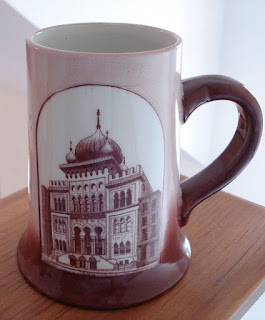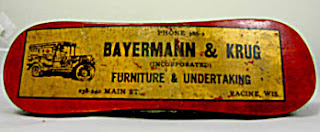 An excellent example of Maddock’s craft is a mug that was made for a convention of the National Association of Master Plumbers held in Atlantic City in 1914. Likely because these same plumbers were installing Maddock sinks and toilets, the company produced a extraordinary vessel. It featured a platinum or silver “art nouveau” design of swirls and bands. By that time, Thomas Maddock had bought out his partners, taken his four sons into the business, and in 1903 died at the age of 85.
An excellent example of Maddock’s craft is a mug that was made for a convention of the National Association of Master Plumbers held in Atlantic City in 1914. Likely because these same plumbers were installing Maddock sinks and toilets, the company produced a extraordinary vessel. It featured a platinum or silver “art nouveau” design of swirls and bands. By that time, Thomas Maddock had bought out his partners, taken his four sons into the business, and in 1903 died at the age of 85. 
 Maddock’s sons continued to be in the forefront of decorated porcelain. The quality of their transfer printing rivaled England and had few peers in the U.S. A prime example of the art is the beer mug shown here. A comely lass with a low cut bodice looks out at us with a slight fetching smile. On the other side we learn that this mug was an advertising give-away from The Broadway of Erie, Pennsylvania, likely a pre-Prohibition saloon.
Maddock’s sons continued to be in the forefront of decorated porcelain. The quality of their transfer printing rivaled England and had few peers in the U.S. A prime example of the art is the beer mug shown here. A comely lass with a low cut bodice looks out at us with a slight fetching smile. On the other side we learn that this mug was an advertising give-away from The Broadway of Erie, Pennsylvania, likely a pre-Prohibition saloon.  A beer stein from the pottery shows wear on both the handle, rim and lettering, suggesting that an “overglaze” transfer was used. This method, while less expensive to produce than under-glaze, is likely to show wear over time since it must adhere to the much harder porcelain surface. Although there have been several breweries bearing the name, this item appears to be from the Acme Brewing Company of San Francisco.
A beer stein from the pottery shows wear on both the handle, rim and lettering, suggesting that an “overglaze” transfer was used. This method, while less expensive to produce than under-glaze, is likely to show wear over time since it must adhere to the much harder porcelain surface. Although there have been several breweries bearing the name, this item appears to be from the Acme Brewing Company of San Francisco.  Important customers for the Maddocks were fraternal organizations, particularly groups associated with the Masons. Shown here is stein that is a excellent example of the family’s ability to produce elaborate decorated stoneware. It shows the Lulu Shriners temple in Atlanta, Georgia, and dates from about 1904. These would have been ordered from the Trenton pottery as souvenirs of anniversaries or other special occasions.
Important customers for the Maddocks were fraternal organizations, particularly groups associated with the Masons. Shown here is stein that is a excellent example of the family’s ability to produce elaborate decorated stoneware. It shows the Lulu Shriners temple in Atlanta, Georgia, and dates from about 1904. These would have been ordered from the Trenton pottery as souvenirs of anniversaries or other special occasions.
The Maddock artisans had the “in house” ability to produce their own transfer engravings and decals in order to customize a standard line of souvenir ceramic forms. They developed a enameling process that allowed the pottery to copy fine line designs from steel engravings, beyond much of the competition’s ability to copy.
 In December 1909 the company provided a celebratory stein for the Tristam B. Freedman Chapter of Masons in Philadelphia. Named for the English immigrant founder of a famous auction house in the City of Brotherly Love, this chapter was founded by seven break-away Masonic brethren in 1873. Note that the symbolism on the stein includes the keystone recognizing Pennsylvania as the Keystone State.
In December 1909 the company provided a celebratory stein for the Tristam B. Freedman Chapter of Masons in Philadelphia. Named for the English immigrant founder of a famous auction house in the City of Brotherly Love, this chapter was founded by seven break-away Masonic brethren in 1873. Note that the symbolism on the stein includes the keystone recognizing Pennsylvania as the Keystone State. Frequent organizational commissions for Maddock were for sets of ware that included a tall pitcher with matching mugs. Shown here is an example of a pitcher made to celebrate the 90th Anniversary of the Northern Chapter No. 25 of Masons from Newark, New Jersey. Dated 1913, this vessel is particular notable for the elegant shading of blue from light to dark. The set below shows another example of the company mastery of design and underglaze transfer printing. It shows men bowling and features attractive silver trim. These ceramics were made for an Eagles Club event.
Frequent organizational commissions for Maddock were for sets of ware that included a tall pitcher with matching mugs. Shown here is an example of a pitcher made to celebrate the 90th Anniversary of the Northern Chapter No. 25 of Masons from Newark, New Jersey. Dated 1913, this vessel is particular notable for the elegant shading of blue from light to dark. The set below shows another example of the company mastery of design and underglaze transfer printing. It shows men bowling and features attractive silver trim. These ceramics were made for an Eagles Club event.
We move from Maddock-produced artsy production to perhaps the company’s most remembered contribution to the American pottery scene: Its football steins. With Harry Maddock listed as the inventor, the company was awarded a patent on this item in January 1905 and produced thousands of them for fans.

 Ivy League schools seem particularly well represented in the output. Shown below are two examples. The Princeton pigskin has the laces showing at the side; on the Cornell example, they sit on the front. Somewhat incongruous, however, is the figure on the latter. It appears to be a track and field participant, a pole vaulter or javelin thrower. Thinly clad as he is, he would be mincemeat on the gridiron.
Ivy League schools seem particularly well represented in the output. Shown below are two examples. The Princeton pigskin has the laces showing at the side; on the Cornell example, they sit on the front. Somewhat incongruous, however, is the figure on the latter. It appears to be a track and field participant, a pole vaulter or javelin thrower. Thinly clad as he is, he would be mincemeat on the gridiron. After the death of Thomas Maddock, his sons changed the name of the firm, to Thomas Maddock’s Sons Company. One son, John Maddock, left and started his own pottery company in Trenton; his mark can be found on items similar to those shown here. The company that Thomas had founded was acquired in 1929 by the Sanitary Manufacturing Company that ultimately became American Standard, a familiar name in bathroom fixtures today.
After the death of Thomas Maddock, his sons changed the name of the firm, to Thomas Maddock’s Sons Company. One son, John Maddock, left and started his own pottery company in Trenton; his mark can be found on items similar to those shown here. The company that Thomas had founded was acquired in 1929 by the Sanitary Manufacturing Company that ultimately became American Standard, a familiar name in bathroom fixtures today.
It is worth mentioning the Maddock firm for two other achievements. The company is given credit for inventing the flush mechanism of the toilet we know today, a highly useful modern convenience. Another is the chamber pot it produced about 1890 that resided in the Lincoln Bedroom of the White House for decades until President Truman’s wife, Bess, gave it away to a servant, likely feeling it had outlived its usefulness.
For a long time it has been my impression that Thomas and his sons have gone without significant recognition for their ceramic creations. Miller’s “20th Century Ceramics,” a standard reference, devotes to the Trenton pottery only a brief paragraph and one photo of a plate. Why? It occurs to me that perhaps the Maddocks’ mass production of bathroom “potties” has led to diminished respect for its decorative pottery.












